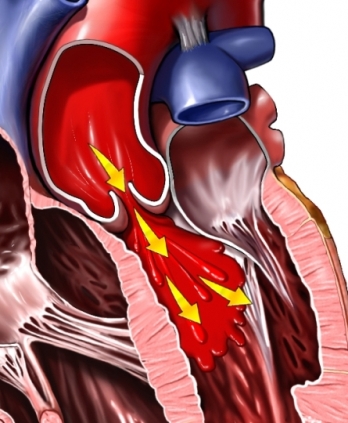Aortic insufficiency – Aortic insufficiency
Description of aortic insufficiency
The left ventricle of the heart is a muscular Chamber, that pumps blood from the heart throughout the body. Blood is pushed through the aortic valve into the main artery, called aortoj. After each heartbeat valve tightly closed, to prevent the blood back to the heart.
Aortic insufficiency occurs, When the valve does not close tightly enough. Most people with slowly progressive (chronic) disease have no symptoms and, perhaps, not need immediate treatment. Aortic insufficiency can also occur acutely (fast), in particular from infection or trauma of the aortic valve.

Causes of aortic insufficiency
Aortal'nuju failure may cause:
- Birth defect, in which the aortic valve is one-, di-, or chetyrehstvorchatym, instead of the normal tricuspid (three valves);
- High blood pressure;
- Bacterial infection of the aortic valve (eg, syphilis, Chlamydia);
- Damage of the aortic valve;
- Some inflammatory diseases (eg, rheumatoid arthritis, lupus erythematosus, Temporal Arteritis, Reiter's syndrome);
- Aneurysm;
- Some genetic diseases (eg, Marfan syndrome, Ehlers-Danlos Syndrome, Cystic Fibrosis);
- Cordial violations (eg, Atrial Septal Defect);
- Unknown causes.
Risk factors
Factors, that increase the likelihood of aortic insufficiency:
- History of aortic insufficiency;
- High blood pressure;
- The use of certain medications (eg, medicines for weight loss and appetite suppression).
The symptoms of aortic insufficiency
The following symptoms may be caused by insufficiency of the aortic valves not only, and other serious illnesses. When you see any of them need to go to the doctor.
- Shortness of breath during physical activity;
- Dizziness;
- Chest pain;
- Cardiopalmus;
- Cardiac arrhythmia (abnormal heart rhythm);
- Swoon;
- Difficulty breathing in the supine position.
Diagnosis of aortic insufficiency
The doctor asks about the symptoms and medical history, performs a physical examination, and then assigns analyses. Tests may include the following:
- Chest X-ray – to take a picture of the chest;
- Echocardiogram – test, which uses high-frequency sound waves (ultrasound), to examine the size, the shape and movement of the heart and assess the condition of valves; usually done on the surface of the chest (the so-called Transthoracic echocardiography);
- Transesophageal echocardiography – type of Echocardiogram, which valve inspection is carried out using an ultrasonic probe;
- Electrocardiogram (ECG) – test, that records heart activity by measuring electrical current, passing through the heart muscle;
- Heart catheterization – a thin tube is inserted into the heart through a vein or artery (usually in the arm or leg), to detect problems with the heart and its blood supply;
- MRT – test, which uses magnetic waves, to take pictures of structures inside the heart;
- CT – X-ray examination, which uses computer, to take pictures of structures inside the heart.
Treatment of aortic insufficiency
Choice of treatment depends on the severity and history of disease, and its impact on the size and function of the heart.
Treatment depends on the severity of symptoms. In severe cases, surgery is required. In chronic and slowly progressive aortic insufficiency treatment may include medications.
Medication
Drugs, applied for the treatment of aortic insufficiency may include:
- Diuretics, to treat high blood pressure and excess fluids from the body;
- Calcium channel blockers can reduce leakage of blood, and in some cases prevent the need for surgery;
- Other drugs (eg, Angiotensin-converting enzyme inhibitors [ACE inhibitors], Angiotensin receptor blockers);
- Antibiotics are used in dental and surgical procedures to prevent infection.
Depending on the condition of the patient the doctor may prescribe periodic physical examinations and Echocardiogram.
If the disease does not progress, the surgery is not required.
Operation
There are several open heart operations, who can fix a leaking aortic valve. Type of surgery will depend on the nature of the abnormalities of the valve and the recommendations of the surgeon. Usually, valve response (it corrected the defect), rather than replaced with artificial.
Prevention of aortic insufficiency
In most cases, this disease cannot be prevented. It is necessary to ask the doctor, should I take antibiotics before dental and other procedures. This can help prevent infection.
